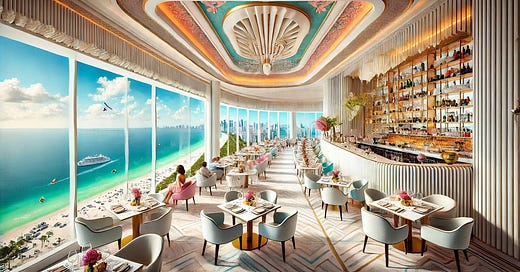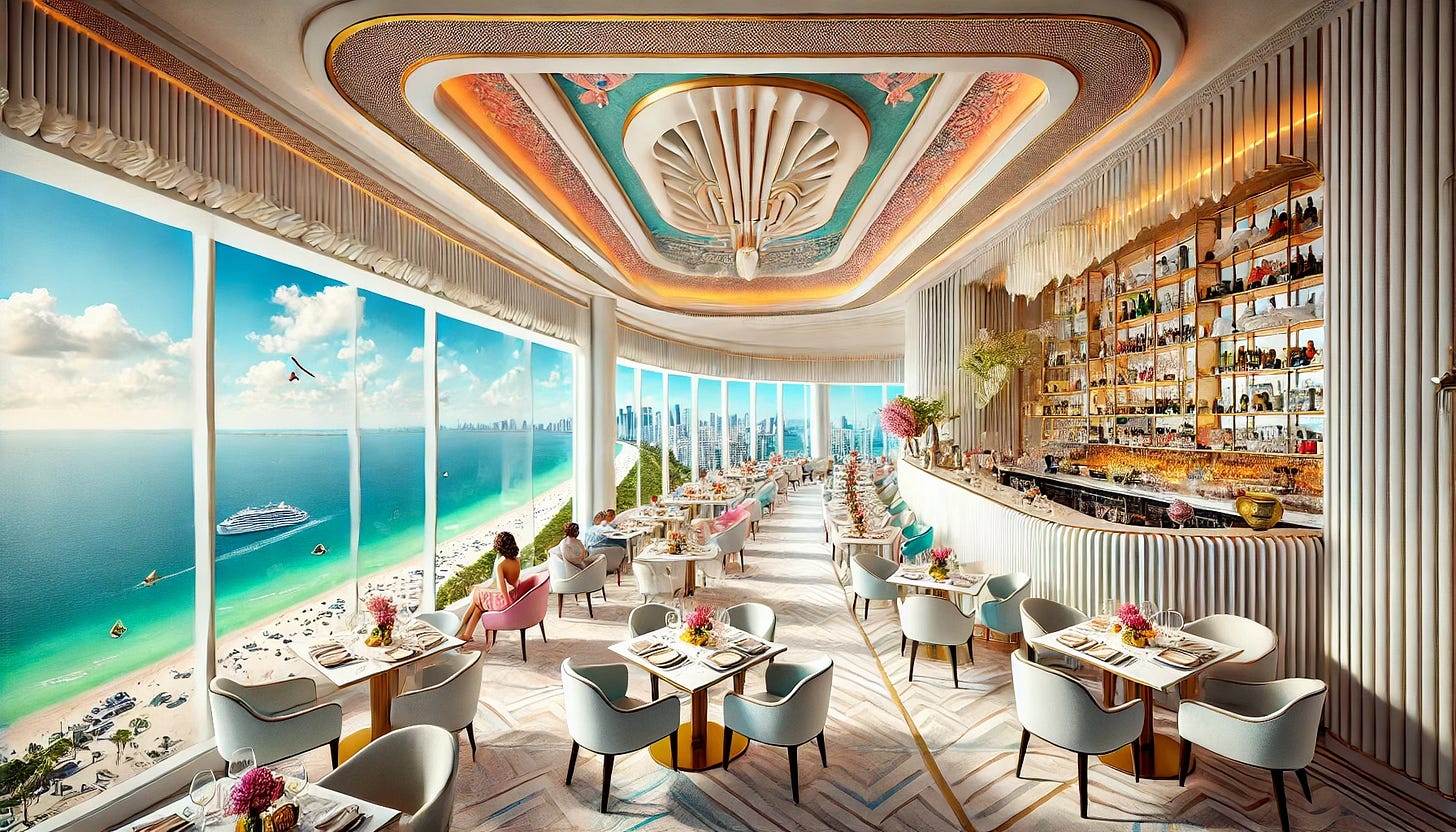How Many $200/head Restaurants Are Too Many?
In Miami, where I live, there exists what I call the “build it and they will come economy,” where high-end condos and restaurants are supplied on the assumption that the demand will not cease. For quite some time, this has been a fine model; the demand has not ceased.
There would seem to be an excess supply in Miami of what I will call “very expensive” restaurants. A “very expensive” restaurant does not have to be good. It just has to be very expensive.
It’s perhaps the case that this glut of “very expensive” restaurants is a nationwide phenomenon. It has recently seemed to me that there is a glut of such restaurants in other city I frequent, Las Vegas. At one property alone—Fontainebleau—nearly a dozen such restaurants opened within a single month last year.
In New York, a hyper-competitive city with a large, discerning population that dines out frequently, a mediocre yet expensive restaurant can't survive long. In Miami, however, it can.
Here, I define “very expensive” as a restaurant where a couple, enjoying drinks and not strictly watching expenses, might expect to spend around $200 per person, including tax and tip. This doesn’t mean that all of these restaurants will cost at least $200 per head every time; rather, it’s an average for diners in a relaxed spending mode.
Now before I dig in to Miami restaurants (and I will, exhaustively, below), it’s worth noting some context. In Miami, there’s a reason to expect that there might be an inordinate number of very high-end restaurants, more than your typical rich global city.
First, twenty years ago, Miami’s nightlife had hubs beyond restaurants: clubs, lounges, and high-end bars once dominated the scene. Now, restaurants have largely taken over as the city’s main nightlife venues.
Second, Miami experienced an extreme Covid boom, and we might now be seeing a delayed supply response to that boom (perhaps many new entrants will be disappointed). In finance, one constant is that if the numbers on the spreadsheet are too good to be true (pot growers in 2018, or Miami restaurants in 2021), then many other people are also seeing those good numbers, and many new entrants will soon appear (causing price declines and/or failures).
Third, Miami has historically seen a high rate of new business openings due to the EB-5 immigration program, which fast-tracks foreign investors for U.S. residency when they invest in job-creating enterprises.
On OpenTable, if you filter Miami restaurants by the “$$$$" tag, all options fit the "very expensive" profile. Although the filter technically represents “$50 and over,” most restaurants in this category have average entrée prices close to $50 (for one entrée, before tax and tip). A search for November 20, conducted on November 2, reveals 128 restaurants in this category for Miami-Dade alone, excluding Greater Miami. By comparison, Manhattan lists only 110 restaurants with the "$$$$" designation on the same date.
Where it gets interesting is if one searches the $$$ category. For Nov 20 (Nov 2 search), one finds 261 Miami-Dade restaurants in this category (there were 246 in Manhattan on the same night). This category is technically $31 to $50, but many will meet the critieria of $200 per head. I’m going to go through and do a count of the $$$ category that I can reasonably consider to be $200 a head.
This is unscientific. It’s based on things I’ve heard or experienced, or, if I it’s a close call, I’m going to the restaurant website and looking at the menu.
Miami Opentable $$$ restaurants that probably cost $200 per head or more, on average.
Azabu, Amal, Amara, Zucca, STK, Contessa, Hutong, Kiki on the River, Erba, Blue Ribbon, Playa Miami, Gianni’s at the Former Versace Mansion, Orilla, Astra, Mignonette, Makoto, A Fish Called Avalon, Katsuya, Tullio , Elastika, Jaya at the Setai, Kyu
That’s 22 restaurants. So we’re at 150 total (22 $$$ and 132 $$$$). All of these restaurants are not quite trying to be very expensive, but it’s something along those lines. Of the 239 $$$ restaurants that I did not include, I suspect that many of the bills are hitting $200/head, but it’s not the norm.
Now add the clearly "very expensive" restaurants that are not on Opentable: Naoe, Ogawa, Hiyakawa, Hiden, Mila Omakase, iki, babette, Sushi Bar (sylvester hotel), Cipriani, Bellini, Novikov, Pastis, El Secreto Omakase, Pao, Los Fuegos, Surf Club Restaurant, Casa Tua, La Martola, Carbone, Aoka, Sunny’s, Sereia, Recoveco, Cote, Shingo.
That’s 25 more for 175 total.
Outside of that, you have the private social clubs. Of those, the one in bold I would classify as mostly dining-focused. Clubs: ZZ’s, Mila, Cipriani, Faena, Bath, Soho Beach, Harbour Club, Moore Miami, Casa Tua, Air, Haiku.
For now, let’s say we’re still at 175, but the trend towards high-end members’ only dining clubs is interesting, as one would assume that these clubs are a pure substitute for open dining establishments.
Most likely, 175 is an undercount. There’s just no way I caught everything through a search of Opentable, Tock, and Resy. Also, I think I’m probably low on the number of $$$ restaurants from Opentable that I rate to be “very expensive.”
What’s the right number of $200+ per person restaurants for a city like Miami? There’s no definitive answer, of course, but let’s estimate that these restaurants, on average, need around 100 covers per night to stay afloat. That would require 17,500 diners each night citywide. Assuming a strong economy, 17,500 diners seems attainable during peak season or weekends, but likely a stretch on weekdays.
Miami’s real estate market is closely correlated with the S&P 500, perhaps more so than any other major city. Around 40% of Miami real estate closings are all-cash transactions, with most funds wired directly from brokerage accounts. It's likely that, like much else in the US economy, the Miami restaurant industry is S&P-driven.
It’s been years since Miami experienced a significant economic slowdown, so the effects on the restaurant scene are hard to predict. In a typical city, during a mild downturn, diners might make three adjustments: 1) ordering more conservatively at high-end restaurants, 2) opting for less expensive dining options, or 3) eating at home more often. In New York, these shifts would likely follow predictable patterns, but Miami’s more “flashy” nature might lead to a more sudden stop in demand. This characteristic makes the city’s dining market feel closer to a binary demand model.





